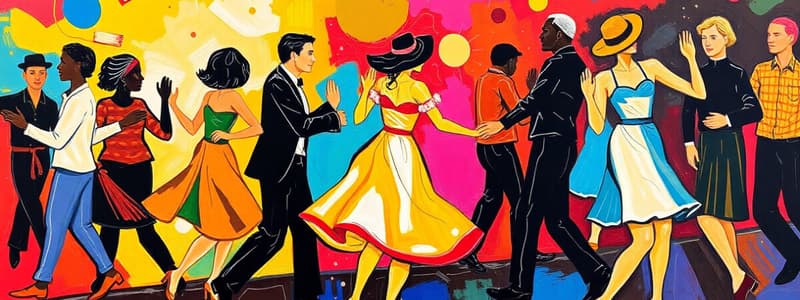Podcast
Questions and Answers
What is line dance?
What is line dance?
Dancing in line to the music with specific numbered steps.
Which of the following is NOT mentioned as a name of a popular line dance?
Which of the following is NOT mentioned as a name of a popular line dance?
- The Tush-Push
- Boot Scootin' Boogie
- The Texas Two-step
- The Salsa Slide (correct)
Line dancing is typically performed with a partner.
Line dancing is typically performed with a partner.
False (B)
From which dances did line dancing evolve?
From which dances did line dancing evolve?
What is a popular line dance that became famous in high school dances in the early 2000s?
What is a popular line dance that became famous in high school dances in the early 2000s?
Match the following line dance terminologies with their definitions:
Match the following line dance terminologies with their definitions:
Flashcards are hidden until you start studying
Study Notes
Historical Development of Line Dance
- Line dancing steps are easy and don't need a partner, making it perfect for singles.
- It evolved from the adaptation of the polka and waltz by American immigrants in the 1800s.
- The dances of the first line did not originate from country-western dance, but from folk dancing.
- Line dancing originated from folk dancing which shares many similarities.
- Contra dancing, a style of American folk dancing, influenced line dancing.
- The hustle dance, popularized in the 1970s, paved the way for line dances set to popular country songs.
- Line dances started being created for popular country songs in the 1980s and 1990s.
- The 1992 hit "Achy Breaky Heart" by Billy Ray Cyrus popularized line dancing.
- Conventional music began to see an upswing in line dancing popularity during the 1990s, propelled by "The Macarena."
Line Dance Format
- Line dances consist of specific numbered steps.
- Line dances have catchy names like "The Texas Two-step", "The Tush-Push", "The West Coast Shuffle", "The Redneck Girl", and "Boot Scottin' Boogie."
Line Dancing Today
- Line dancing is taught and performed in country-western dance bars, social clubs, and dance halls around the world.
- A newer version of the electric slide, called the “Cha-cha Slide,” was created in 1996.
- The "Cupid Shuffle" rose in popularity in high school dances during the early 2000s and is still played in clubs today.
Terminologies
- Accent - focus on a given or movement.
- Back Cross - the nominated foot crosses and touches behind the other foot.
- Behind - a step with the free foot crossing behind the weighted foot.
- Brush - swing the foot back or forth.
- Across - one foot movement in front of the other.
- Balance Step – a step in any direction followed by a close step and a hold.
- Break – a change in direction.
- Bump - hips shift to the side.
Studying That Suits You
Use AI to generate personalized quizzes and flashcards to suit your learning preferences.




